What's in store for investors in 2020? What are the opportunities that lie before us? Where can we make our greatest profits? How can we grow fatter accounts for the new year?
Let me share with you my US stock market forecast for 2020.
In this article:
- US Stock Market Forecast 2020: The Macro Picture
- Company Fundamentals and Valuation
- Technical Analysis
- My Overview and Strategy for US Markets in 2020
- 2020 Events That Could Trigger High Volatility
US Stock Market Forecast 2020: The Macro Picture
Let’s start off by looking at the big picture. The US is currently entering a record 11th year of economic expansion. It started in 2009, and right now 2019 is over—it's been 11 years of economic growth.
The Federal Reserve has reversed from rate hikes to now rate cuts. The Fed has been raising interest rates for the last five years because of the recovery, but due to the recent trade war and some slowing growth in China and the US, they have started to cut interest rates temporarily. Personally, I don't see them raising rates before the election. I see them holding rates, or even cutting a bit more for 2020.
Now, this year’s earnings growth for the S&P 500 companies is expected to be a lot higher than last year. Last year’s 0.9% growth was really low; this year, earnings growth is expected to be 9.6%, which is above the 10-year average of 9.1%.
All sectors are expected to show earnings growth—specifically, double-digit growth is expected from the energy sector. Why? Simply because energy has been in a recession for a long time, the earnings are terrible, many companies are losing money, so they expect there to be a turnaround in the energy sector, as well as the industrials and materials sector. So that's where most of the recovery is coming from.
Look at this chart over here. You can see that we’re expecting not just growth in the US but the beginning of global, real GDP growth in 2020, after a small dip back in 2019. We think that it's bottomed out, and it's going to start to grow again. So that's the bullish economic news.
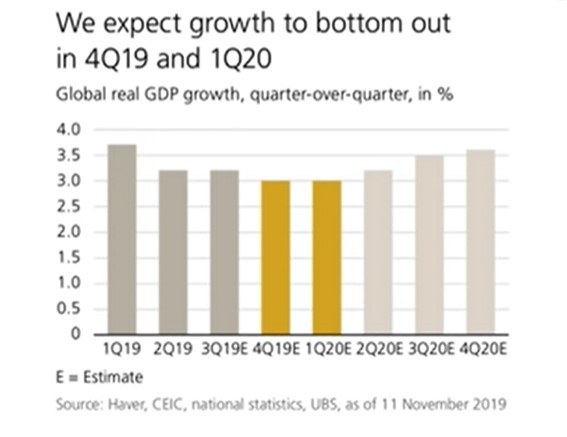
Company Fundamentals and Valuation
To me, economic news and growth forecasts are not the most important. The most important thing in investing is picking very good companies that have a wide economic moat. In my Whale Investor™ Value Momentum Investing™ course, I share my exact strategy on how to identify the best companies.
Now, we only buy the companies when they are undervalued. The way to make money is to buy when the stock is selling below its intrinsic value. Right now in the US, most stocks are not cheap anymore. Prices have gone up quite a bit so share prices are now slightly above their fair intrinsic value.
P/E Ratio of S&P 500 from 1954 to Present
Now if you look at the S&P 500 overall, the P/E ratio is now 21.59. From 1954 to present, the P/E ratio has gone as low as about five, and as high as about 30. The average P/E ratio for the last 65 years has been about 16.56.
This means that generally, anything above that is above fair value (i.e. expensive), anything below that is undervalued. Right now at 21.59, it is above 16.56, which means that overall the US market is not cheap.
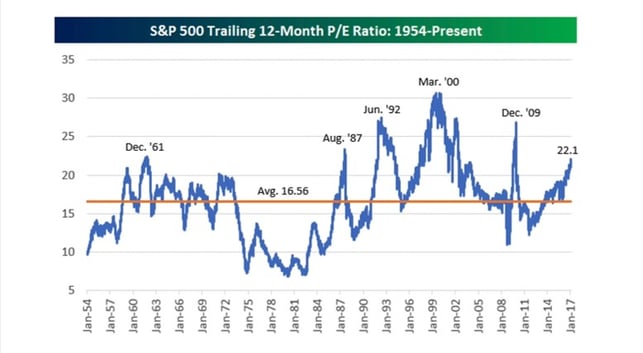
While the US market is expensive, I wouldn't say it's in bubble territory yet, which means it can still go higher. Because historically, the P/E ratio has gone as high as 26 or even 30 before it burst. So while it’s not cheap now, it’s not overly expensive.
If you look at individual sectors, the energy sector is still undervalued because it's been in a recession. Financials are a bit expensive right now, consumer staples are expensive, consumer discretionary is expensive. Interestingly, although technology has performed really well last year at 40% return, I wouldn't say it's really expensive, it is still fairly valued.
In fact, if you look at the intrinsic valuations, you can calculate the true value of the company based on its cash flow of its debt and its assets. (If you’ve attended my Whale Investor™ Value Momentum Investing™ course, you would have received my Intrinsic Value Calculator tool.)
Intrinsic Value of Amazon (AMZN) in January 2020
So for example, using my Intrinsic Value Calculator, I can see that the current intrinsic value of Amazon is about $2,000 per share. Amazon is now selling at $1,800 per share. So Amazon is still undervalued, and it's still a reasonable time to accumulate its shares.
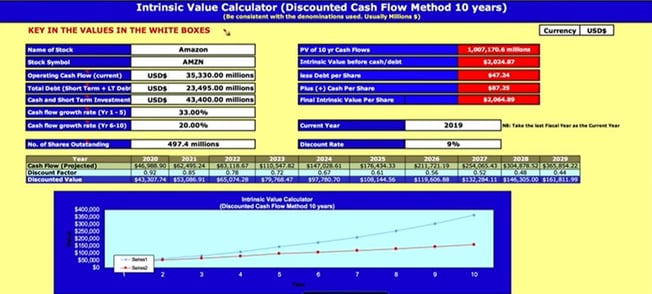
Intrinsic Value of Alphabet (GOOGL) in January 2020
If you look at Alphabet, also known as Google, the intrinsic value is $1,454. The price of Alphabet now is $1,361, so it's slightly undervalued. Interestingly, technology companies are still undervalued, except for Microsoft and Apple which are really expensive. But many of the companies I'm holding are still fairly valued.
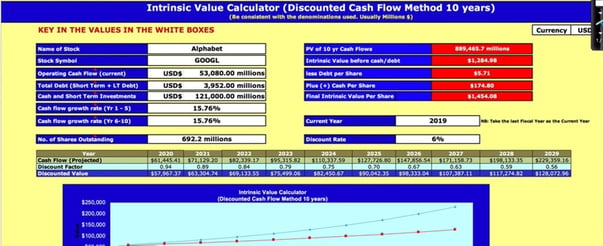
Intrinsic Value of Facebook (FB) in January 2020
Facebook's intrinsic value is $263 per share. Currently it's selling at $210 per share, so Facebook is still quite undervalued.
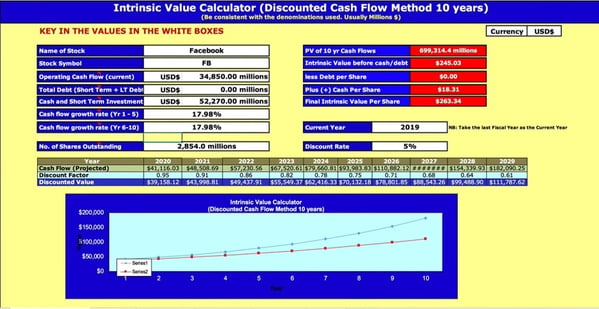
Technical Analysis
Besides looking at company fundamentals, I like to look at the charts to know the overall trend of the market. Are we on an uptrend or downtrend, or consolidating?
I always say, “The trend is your friend.” Never attempt to predict or outsmart the market, just follow the market. As long as the market is on an uptrend, you keep going long, you keep buying, keep being bullish. When the market reverses to a downtrend, get out. You can short the market, you can hedge your positions.
Technical Analysis of S&P 500 (SPX) in January 2020
If you look at the S&P 500, right now we are on a very clear uptrend—prices are making higher highs and higher lows. Moving averages are sloping upwards, indicating a strong uptrend.
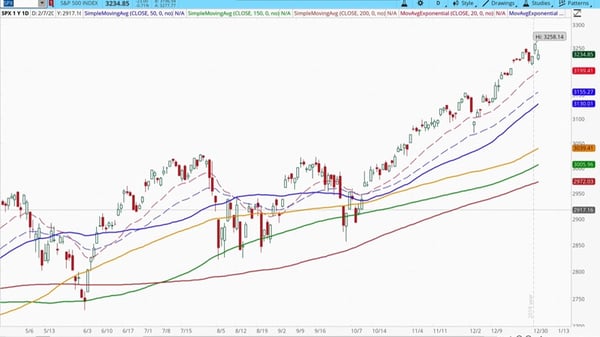
Having said that, do note that we are now at the top of the uptrend. Remember that prices move in wave patterns, breathing patterns—it doesn't go up in a straight line. It has to breathe in, breathe out, breathe in, breathe out. Market prices are made up of the impulsive wave and corrective wave. If you look at these wave patterns, right now we are breathing out towards the end.
Now, it's very hard to tell exactly where's the top, right? But you know that it will eventually have to come back down again, to one of the moving averages, maybe the 150-day moving average or the 200-day moving average.
Once it comes back down, that's when I get in the market again and I start adding more shares. I never buy near the top, because the moment you buy, you will need to wait for a retracement before getting in again. This is true for both the overall market and for individual companies.
Technical Analysis of Facebook (FB) in January 2020
Facebook is on an uptrend, but although it is undervalued based on fundamentals, I will not buy in now at the top of the uptrend (about $208). I want it to come back down to about $188 before I start buying again to catch the next wave up.
We always want to buy the dip on the uptrend; never buy the high on the uptrend, never chase it once it's moved off. You can also look at the weekly candles to give you some perspective.
You can see a strong support over here. So it's wave up wave down, wave up wave down, wave up. I wait for wave down before accumulating shares over here.
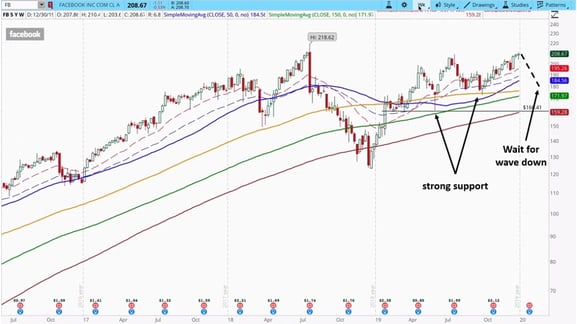
So in general stocks are fairly valued, but there are a couple of technology companies that are still cheap, like Facebook, Alphabet and Amazon.
Technical Analysis of Apple (AAPL) in January 2020
Apple is really expensive right now, so I would definitely not buy Apple right now. You can see Apple has been on a tear, look at that, all the way up.
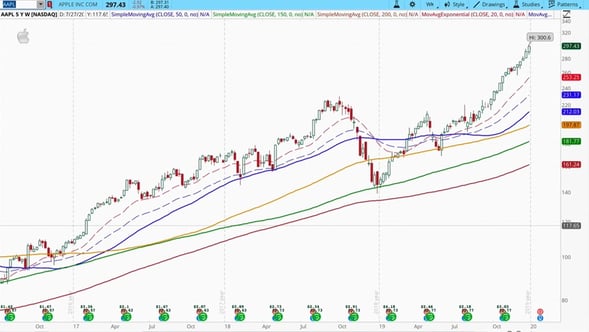
But it's not going to go up forever, eventually it has to come back down, so I'm going to wait for it to come back down to about $198 before I start buying Apple again. And after I buy it, I will wait for the next wave up again. Always be patient, never chase a stock.
Of course, there are some stocks that I went into that have not recovered yet. Because I like to buy stocks that have been hit by bad news, sometimes they may take months or even a couple of years to recover. One such example is Boeing.
Technical Analysis of Boeing (BA) in January 2020
You can see Boeing has been stuck in consolidation, bouncing between the support at about $320 and the resistance at about $390.
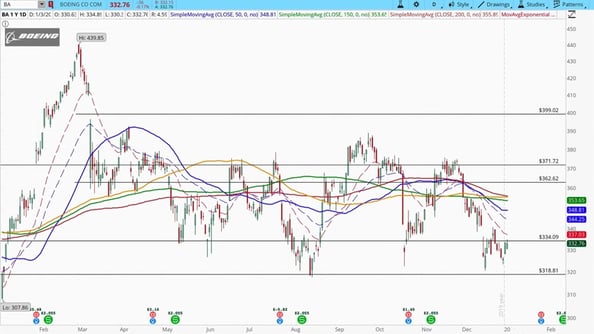
Now Boeing has only one competitor which is Airbus, so I believe Boeing will eventually sort out its problems and go to $450, $500, $600. When will it happen? I've got no idea. The thing is, I make money by buying it when no one wants it.
Right now Boeing is at the support level, it is not a bad time to accumulate shares. If it goes lower, I'll just buy more, because I know that eventually it will break out of consolidation into a new high. So I'm still holding steadily to Boeing now.
In summary for the US market technicals, stocks are on a very clear uptrend, but they are right now at the top of the uptrend at overbought levels. Many indicators are overbought, so I do expect a healthy correction soon, maybe 5, 10 or 15% correction, back to the moving averages. When prices are cheap again, that's when I'll start buying.
Remember: What goes up must come down, before going higher.
My Overview and Strategy for US Markets in 2020
Here’s my outlook for the US markets this year: As long as the trend remains up (and I think it will), I expect positive returns. But I expect lower returns in 2020 compared to 2019. In 2019, we were up almost 29%, and it's not realistic to think that we're going to get another 29% in 2020.
Hedge and Protect My Portfolio Using Options
In 2020, I expect probably 5-7% returns from the overall market. I expect a correction back to the moving averages. In anticipation of a healthy correction, I use options as a hedging strategy. I highly recommend you to enrol in my Options Ironshell™ trading course to learn how to protect your portfolio. So that when the market comes down, the options will generate profits to offset the temporary drop in your portfolio value.
I use many bearish option strategies. For example, I go long on the VIX, which is a fear index. I use what is known as a bearish SNIPEX calendar spread. (The SNIPEX strategy was invented by my friend Bang Pham Van, and it's taught exclusively in our Options Ironstriker™ trading course.)
At the same time, I sell covered call options on my stocks to generate extra income. So even if the market crawls sideways for the whole year, or the market goes down, I still earn premiums every month. The premiums I get are about 2% a month; it may not seem like a lot but 2% a month is 24% return a year. Even if the market goes nowhere this year, I make 24% return, isn’t that great?
Be Patient and Wait for Market Correction
I don't have much to buy at current levels, because I think things are a bit expensive. I'm waiting for the market to correct, to go down at least 10, 15 or even 20% before I start buying again. Because I like to buy undervalue, I like to buy when it's cheap. I'm waiting for the next bad news, for the market to panic, for people to dump their shares—that’s when I'm going to strike.
Let me show you these interesting statistics. You can see that, most of the time, the US market ends up going up. How often does the market go up between 0-10%? Pretty often, right? 10-20%? Very often as well. 20-30% is the most common in fact.
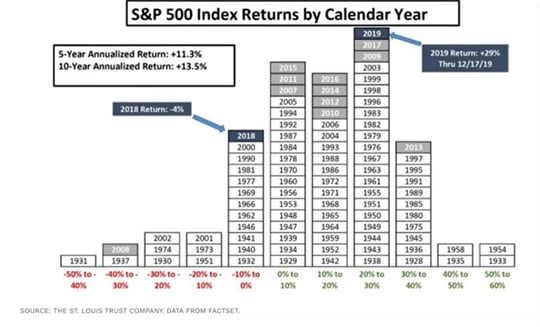
You can see that during recessions, markets have dropped up to 50%. But huge drops above 30% were very rare, it only happened three times in about 90 years, since 1920. When market dropped, it was usually between 0-10%.
It's good news when markets drop 10%, because that's a healthy correction to buy more before prices go back up. Remember, what goes down will always go up, provided you buy fundamentally good companies that pass the screening process.
2020 Events that Could Trigger High Volatility
What could cause the markets to correct in 2020? Like I said, I expect the market to go back down (it’s only healthy and natural), and that's when we buy shares at discounted prices. There are two events I'm watching.
US-China Trade War in 2020
The first major event for the year is of course the ongoing trade war. Recently, there's been a bit of a “phase one” deal between the US and China, but don't expect it to last. It's only a matter of time before things flare up again. The Chinese are going to not do certain things, Trump's going to tweet and things are going to blow up again, right?
But when that happens, I love it because it means the market will get volatile again, and volatility is an investor’s best friend. Volatility allows us to buy shares when people are panicking and selling them at a ridiculous price.
When the trade war erupts again, these are the sectors and industries likely to get affected:
- Semiconductor and electronics manufacturers, e.g. Micron Technology (MU), NVIDIA (NVDA), Intel (INTC), Advanced Micro Devices (AMD)
- Retailers, e.g. Bed Bath & Beyond (BBY), Dollar Tree (DLTR), Abercrombie & Fitch (ANF)
- Auto manufacturers
- Agriculture
Personally, I avoid all these sectors because I don't like sectors that are price competitive, that don't have a strong competitive advantage. These companies are more likely to get affected by the global trade war.
US Presidential Election in 2020
The other main event I'm looking at is the US presidential election coming up on 03 November 2020, where Donald Trump will face off probably another Democrat. This will have huge implications on taxation and industry regulations.
If the Democrats were to win the White House and Congress and gain control of the government— especially if the Democrat is very left-leaning like Elizabeth Warren or maybe Bernie Sanders—they are quite anti-business and they would want to break up the banks, end private health insurance, break up the technology companies.
Their win could spark a sell-off in technology, healthcare, financials and energy companies. There will be a lot of panic causing people to sell their shares. I will use this opportunity to buy my favorite companies at huge discounts.
In conclusion, I look forward to the trade war and election, and I look forward to the volatility that will happen, as this gives me the chance to buy great companies at cheap prices.
Want to know what high potential stocks I’m looking at in the US market? Check out my Ultimate Investors Playbook.



submit your comment